It’s no secret that India’s traditional art holds a place of pride in the world, thanks to its wealth of creativity, vibrancy and diversity. Even though we all bask in the glory of our country’s amazing artistic heritage, not many of us are aware of some incredible facts and stunning trivia behind these beautiful, ingenious works. Here are 5 incredible facts about Indian art that will amaze you.
The Popular Warli Art
Today, when we think of ethnic home decoration collection and clothes wear, Warli paintings come to our mind. Today it is used on mugs, lanterns, walls, paintings, and bed-sheets. But do you know the gorgeous Warli art dates way back to almost 3000 BC? Warli painting is a form of tribal art mostly created by the people from the North Sahyadri Range in India. This range encompasses cities such as Dahanu, Talasari, Jawhar, Palghar, Mokhada, and Vikramgadh of Palghar district. This tribal art originated in Maharashtra, where it is still practiced today.
Pattachitra
It is a century old technique from Orissa that uses palm leaves for the portrayal of epics and folklore. In a bid to create awareness about contemporary issues, the chitrakaars are using the narrative scrolls to highlight geopolitical events and social issues like carnage at Nandigram, Mumbai blasts, HIV, unemployment and climate change.
Madhubani
Can a painting prevent deforestation? Madhubani, the art style from Bihar, famous for its beautiful illustrations of Hindu deities has successfully achieved this feat. In 2012, a bunch of artists created vibrant masterpieces on barks and trunks to restrain people from felling trees. And voila, not a single painted tree was chopped! The highway number 52 of the Madhubani district is a well-known tourist destination today.
Kerala Murals
Kerala murals, one of the world’s finest art frescos that date 3500 years back were 100% eco-friendly. The complex layering and harmonious shading in these classical artworks famed for depicting mythology and legends are still done with natural pigments and vegetable colours.
The 100% Organic Kalamkari
In the age of large-scale textiles, there are still artists who do Kalamkari paintings on fabrics. Kalamkari or qalamkari is a type of hand-painted or block-printed cotton textile, today mainly produced in Iran and India. The word Kalamkari is derived from Persia where qalam means pen and kari means art or craftsmanship. In other words, drawing with a pen. This ancient form of art is completely organic. From the brushes to the dyes to the cloth, everything is 100% natural.






















